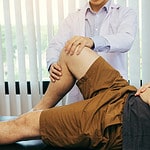Understand the Injury
Staying positive and motivated during knee injury rehab is essential. To do this, understanding the injury is key. Learning more can help you manage recovery and provide clarity on how to move forward.
To understand the injury, get a proper diagnosis. Also, research it and talk to healthcare professionals. This will enable you to create a plan of action.
Learn about the anatomy of the knee
To comprehend an injury and make a thorough rehab program, it’s essential to have insight into the knee’s anatomy. The knee is a difficult joint consisting of three bones, three main ligaments, muscles, and tendons.
The bones are the femur (thigh bone), tibia (shin bone), and patella (kneecap). The ligaments are the anterior cruciate ligament (ACL), posterior cruciate ligament (PCL), and the medial collateral ligament (MCL). These structures give stability in various movements, especially when jumping and cutting. The muscles and tendons become active to stabilize the knee joint in these movements.
It’s critical to know about potential injuries that could happen due to physical activity or trauma. For instance, the ACL can tear if there is too much pressure around it during cutting or pivoting motions. Other injuries involve tendonitis in the quadriceps or inflammation in any of the other structures near the joint capsule.
Familiarizing yourself with this anatomy will support you to understand your injury, and also create a useful treatment plan that focuses on strengthening weak structures and keeping flexibility for better range of motion. Appropriate diagnosis is indispensable for staying positive during rehab since knowing what you are injured from can be motivating and provide direction for recovery goals!
Understand the types of injuries
When managing a knee injury, it is essential to understand the type of injury and its associated anatomical structures. This provides a clear picture of rehab strategies and is important for making decisions.
Injuries are caused by overuse, trauma or degenerative conditions and fall into two categories; structural and functional. Structural injuries damage muscles, tendons and ligaments. Functional injuries refer to how these parts interact with each other.
Common structural injuries include:
- Ligament sprains: Strained or torn tiny fibers attaching bone to bone
- Tendonitis: Pain due to inflammation or overemphasis
- Cartilage tears: Damage to cartilage or meniscus between joints
- Fractures: Bone breaks or cracks from low trauma events
Types of functional injuries include:
- Joint instabilities: Loss of stability from muscle imbalances or mechanical flaws
- Meniscal derangement: Injury causing tears in the cartilage discs (menisci) beside the kneecap
Understanding the type(s) of injury helps patients when discussing treatment plans. It also helps stay positive during the process. Knowing “why” motivates rehab efforts and helps with recovery.
Have realistic expectations of the recovery process
Be realistic when setting a timeframe for your injury rehab. Accept that it will take some time. Over-expecting can lead to disappointment and frustration. Understand the mechanics behind the injury. Research and ask questions to know how long it’ll last.
Know that progress will be slow, but with each step, you’ll get closer to the goal. Having realistic expectations is key for staying positive during rehab. And remember, even though it may feel slow, every small victory should be celebrated!
Set Goals
Want to remain positive and motivated during knee injury rehab? Great! Setting goals is the way to go. These can be for the end of the week, or even further down the line. Having something to strive for can keep you motivated and give you focus. Let’s find out how to use goals to your advantage during rehab.
Set short-term and long-term goals
Goal setting is a must for knee injury rehabilitation. It will keep you motivated and focused on recovery, help you track progress, and recognize what needs more work. When deciding on goals, ask yourself:
- What do I want to achieve in the short-term?
- What do I want my knee to feel like in the long-term?
- What does success look like for me?
Make goals realistic and achievable. Short-term goals could include activities like walking longer distances, climbing stairs with ease, or increasing balance. Long-term goals could involve participating in former activities with minimal restrictions, or walking with no pain.
Goals should be specific and measurable. Telling your physical therapist your plan can help keep track of tasks and help you reach success after knee injury rehab.
Make a plan for achieving your goals
Identified your goals? Great! Now it’s time to create a plan to reach ’em. Make it realistic and achievable. Break it down into small steps.
E.g. If your aim is full range of motion in two months:
- Go to physical therapy 3x/week
- Follow PT’s stretching recommendations
- Gradually increase knee range of motion exercises
- Track progress and review with PT
- Set new goals & reward yourself for progress
Set deadlines for each step. Make sure you have enough time to hit the goal. Think about any barriers that may prevent success and plan ways around them. Lastly, check with your doctor or PT before making changes to rehab exercises. They will tell you which exercises are safe for you.
Stay Positive
Rehab for a knee injury isn’t easy. You may feel frustrated, anxious and overwhelmed. But, it’s important to remain positive. Set goals and reflect on your progress. This article provides strategies to stay motivated and upbeat during your knee injury rehabilitation. Keep your chin up!
- Set goals and reflect on your progress.
- Keep a positive attitude.
- Stay motivated and upbeat.
Focus on the positives
Knee injury rehab can be tough. It’s normal to get frustrated, but it’s important to stay positive. Keep a good outlook and your motivation will stay high. Here are some tips to stay positive:
- Acknowledge each gain you make.
- Be patient; healing takes time.
- Celebrate all successes.
- Build a support system with family, friends, and therapists.
- Visualize success; break down goals into chunks to stay motivated.
Avoid comparing yourself to others
No two bodies respond the same to injuries or treatments. Don’t compare your progress to someone else’s. Everyone’s experiences with healing are different. Depending on your injury, one may heal faster than the other. This doesn’t mean one path is right and yours is wrong. It just means you are both on different healing journeys.
It can be discouraging if you feel like you aren’t getting better as quickly as someone else with the same injury. But if you stay patient, focused, and motivated to do what your doctor tells you, you can make a full recovery.
Talk to family members or friends who have been through a similar situation. Remember that many people have made full recoveries from knee injuries and surgeries. Stay positive that you can make a full recovery too:
- Stay patient, focused, and motivated to do what your doctor tells you.
- Talk to family members or friends who have been through a similar situation.
- Remember that many people have made full recoveries from knee injuries and surgeries.
- Stay positive that you can make a full recovery too.
Celebrate small victories
It’s important to recognize and celebrate small victories when recovering from a knee injury or any other serious injury. Celebrations help with positive behaviors and can lead to long-term success. Additionally, they support motivation when progress is slow.
Set realistic goals and challenges and create a milestone chart to track progress. For example, if trying to regain range of motion, make a chart with targets like bending the knee 45 degrees. Celebrate these milestones as they show progress.
Doing enjoyable physical activities like swimming or cycling offers a great opportunity to celebrate. They are low-impact, so safe for rehabilitation and help with range of motion and strength. Plus, celebrating victories involving activities can build confidence and help with ongoing participation in physical activity.
Celebrate something that brings joy and strengthens motivation when dealing with an injury like a knee sprain or ligament tear.
Stay Motivated
Rehabbing from a knee injury can be exhausting. It’s a tough journey that could take weeks, or even months. Staying motivated throughout can be hard. But, having a good outlook and setting mini, achievable aims can keep you on track.
Let’s look at some tips to stay motivated and get the most from the rehab process:
Find activities to keep you occupied
During injury rehab, it’s important to find ways to stay busy. It can be hard to do when your movement is limited. But there are plenty of options! Brainstorm activities that don’t require being on your feet. Crocheting or needlepoint could be a new hobby. Get into a good book series. Check out a virtual book club for literature talks. Look into online classes for music or philosophy. Even surfing the internet can be fun.
For upper body workouts, do low-impact exercises like stretching and yoga. Core and arm exercises with dumbbells at home are great too. Exercise helps with stress, motivation and healing. Take the time to properly heal, while still staying active in the comfort of your own home.
Join a support group
Connecting with others who are experiencing the same challenges can be very helpful in recovery. It’s normal to have good days and bad, and to feel discouraged. Joining a support group can make a difference!
You can find online or in-person groups for knee injury recovery. Ask your physical therapist or doctor if joining one would help you stay motivated and positive during your rehabilitation journey.
Find ways to stay connected with friends and family
Studies have shown that social engagement and support are essential for successful rehabilitation. Isolation can lead to depression and a lack of motivation. Hence, staying connected during recovery is important. It provides emotional support and keeps you focused on short-term goals.
There are various ways to stay connected during knee injury rehabilitation:
- Schedule virtual visits.
- Host video conferencing calls with friends and family.
- Participate in online gaming/fitness challenges.
- Organize online movie/TV series watch parties.
- Publish updates on social networking sites.
- Attend online fitness classes or workshops.
Connecting with others during recovery is encouraging. It also distracts from the monotony of exercises like stretching, stationary cycling, pool walking, etc. Moreover, it is helpful for finding information/resources related to injury prevention or treatment options.
Seek Professional Help
Knee injury rehabilitation can be tough! To stay positive, seek help from a pro. They can provide guidance with exercises, create the right plan for you, and offer moral support. Plus, they can provide tips on avoiding further injuries. Get the professional help you need. It’s important!
Talk to a physical therapist
Stay positive and motivated during knee injury rehab – talk to a physical therapist! They can provide a personalised plan and help you set goals. Ask them about exercises or stretches specific to your programme. Knowing what exercises and schedule you need will make a big difference in staying motivated.
Consult with a mental health professional
Rehabilitating a knee injury can be daunting. You might feel frustrated, scared, or doubtful about the process. Pay attention to your mental health and look for ways to stay positive.
Talking to a mental health professional can help you stay motivated. They can provide feedback on possible add-on treatments like meditation or mindfulness that could lower stress. They are also great support and can give unique tips on problem-solving or coping strategies. Plus, they can help plan your return to activity when you’re recovered.
Most importantly, they can be a safe space to express your worries like performance expectations, recovery rate, or fear of re-injury. Talking through these issues can help create a realistic plan for achieving your goals.
Take advantage of other resources available
Take advantage of other resources. Professional medical and psychological help can help those with mental illness. Experts, such as psychologists, psychiatrists, social workers, and therapists, can provide evaluations and treatments. Medication might be necessary. There are therapies to help people cope with their condition, now and in the future.
Self-help groups provide emotional support and a chance to connect with others who have had similar experiences. Everyone’s journey is individual, so expert help is essential to find the right path to recovery.
Frequently Asked Questions
Q: What Activities Should I Avoid During Knee Injury Rehabilitation?
A: During knee injury rehabilitation, it is important to avoid activities that involve twisting, running, jumping, or any activity that puts a lot of stress on the knee. It is also important to avoid excessive weight-bearing activities until your doctor has cleared you to do so.
Q: What Can I Do to Stay Positive and Motivated During Knee Injury Rehabilitation?
A: To stay positive during knee injury rehabilitation, it is important to stay focused on the long-term goal of full recovery. Find activities that you enjoy and that can be done without putting too much stress on the knee, such as walking, swimming, or yoga. Setting achievable goals and celebrating small successes along the way can also help to keep you motivated and on track.
Q: How Can I Manage Pain During Knee Injury Rehabilitation?
A: Pain management during knee injury rehabilitation is important for keeping you motivated and on track. Talk to your doctor about any pain medications or physical therapy techniques that may be helpful. It is also important to take breaks when needed and to not push yourself too hard.





